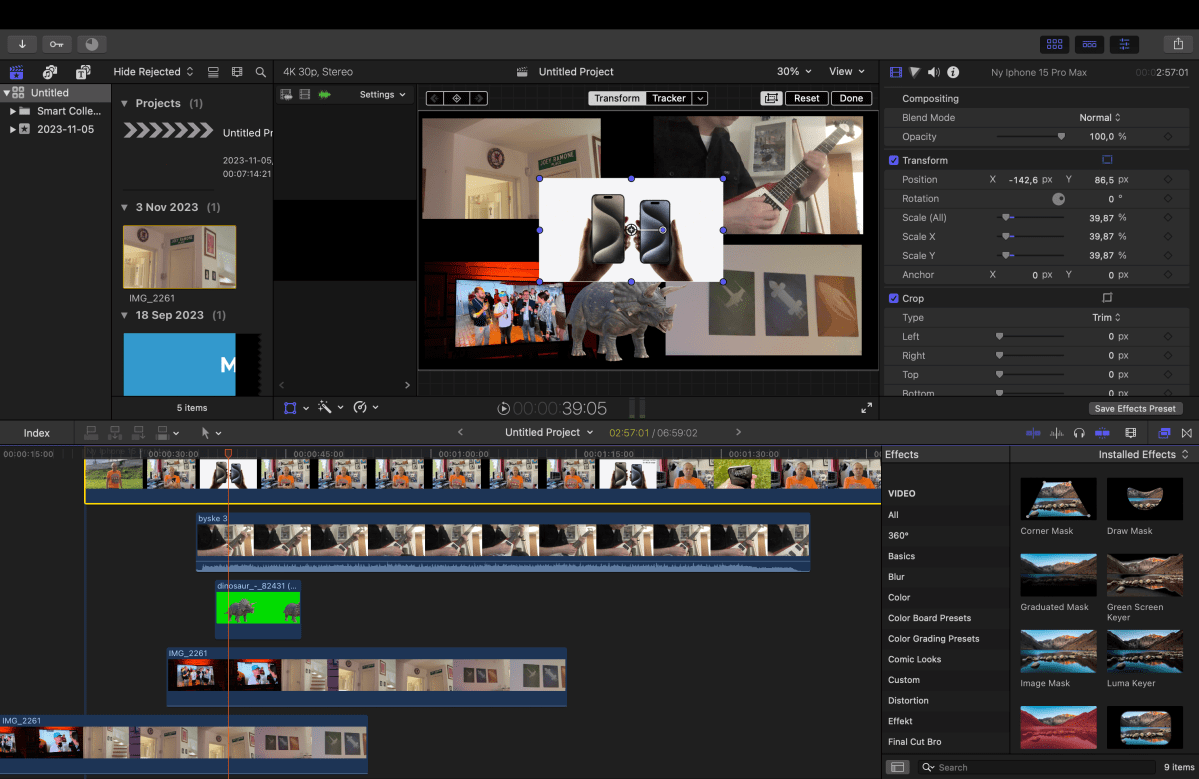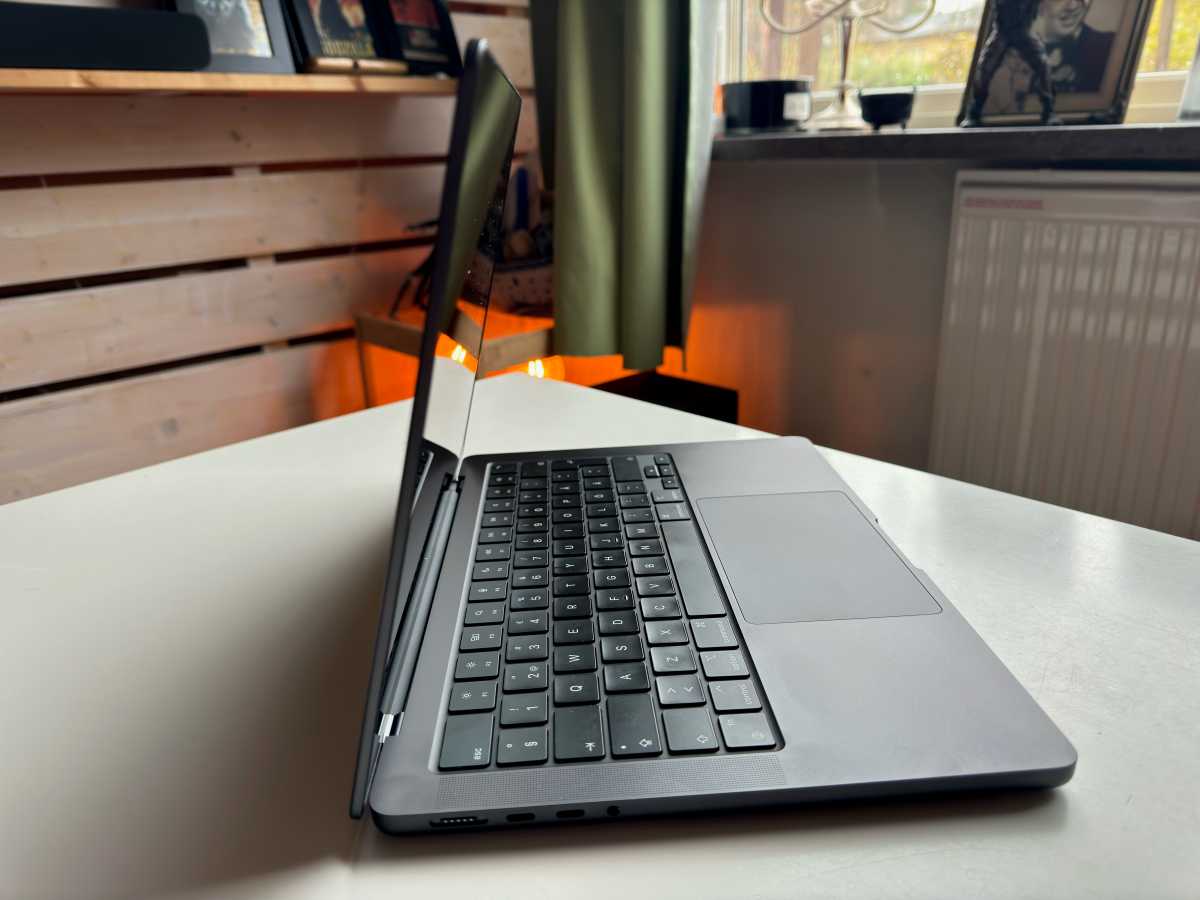Expert’s Rating
Pros
- Powerful
- Long battery life
- Stylish, compact & light
- Great screen
Our Verdict
Yes, it’s expensive, but damn what a computer it is! Apple’s new SoC (system on chip) M3 Max is blazingly fast and still the most energy efficient in its class. There’s no other computer besides Apple’s that offers the same high performance with the same low power consumption. And the new black colour transforms the Macbook Pro from a stylish computer to a sexy one.
Price When Reviewed
From $1,599 | Model reviewed $3,199
Best Prices Today: Apple MacBook Pro 14 (2023)
$1,449.00
$1694

$1799

$1849
The new M3 makes the Macbook Pro even more powerful while giving you performance that lasts and lasts. But before we get into the details, it’s worth talking about Apple’s new Macbook Pro computers.
Prices for the 14-inch MacBook Pro start at £1,699 and there are five SKUs to choose from rising up to £3,299 for the M3 Max model tested here. You can buy it from Apple as well as retailers such as BestBuy and Amazon in the US and John Lewis, Amazon and Currys in the UK.
Check out our round-up of the best laptops for more options.
RIP touchbar – missed by no one
Firstly, the 13-inch with touchbar seems to have fallen by the wayside. I may miss the form factor, but the touchbar will be missed by few. Instead, it is replaced by the 14-inch Macbook Pro with the entry-level M3 chip. That computer has two Thunderbolt/USB 4 ports instead of three, which you get when you buy a Macbook Pro with M3 Pro or Max.
The computer I’m testing now is a Macbook Pro 14 with the M3 Max, with 2TB of storage and 64GB of memory. And it’s black.
Apple had black Macbooks for a while in mid-2000, but they weren’t made of aluminium. This one has the same design as the ones released earlier this year, and together with the black colour, it’s absolutely gorgeous.
So there’s a high “want” factor on this bad boy.

Petter Ahrnstedt
Bright and sharp screen
The screen is, as before, a Liquid Retina XDR display with a resolution of 3024 x 1964, P3 colour gamut, 1,000 cd/m² continuous brightness across the entire screen, which can peak up to 1,600 cd/m² for HDR content. It also has a dynamic refresh rate up to 120Hz.
Or, in simpler and fewer words, the screen is very good, with a big bump in brightness when needed.
Apple’s touchpad beats everything on Windows
All Macbooks have been gifted with a fantastic touchpad. Computer users still stuck in the Windows swamp won’t know what they’re missing. It’s precise, responsive, and comfortable to work with. The keyboard has a perfect stroke length and is, as usual, backlit and equipped with a fingerprint reader.

Foundry
Same goes for the operating system; Mac OS Sonoma is really good and has a lot of fun features and some not so good ones. Yes, we’re looking at you, Eyecatcher. One feature that’s only available on an M3-equipped Macbook is the ability to choose whether to throttle back performance or run as normal when using battery power.
This is the M3
Apple’s new processor is the first in the world to use a 3-nanometre process. Why is this so important? Well, the closer two transistors are to each other, the shorter the distance they have to travel from point A to point B. Shorter distance also means shorter time; it’s faster. If the electrons also travel shorter distances, it also means less resistance, which leads to less energy consumption and less heat generation.
Here, Apple is way ahead of the competition. Even when the computer is doing heavy work, such as rendering video, it doesn’t get hot. The fan rarely kicks in. And it’s fast.
Set your phasers to slow down
And here it’s time to stop and geek out on comparisons with the M1 and M2 Pro. If we look at Apple’s own hardware specifications, the M3 Pro has 150Gbps of memory bandwidth. The M1 and M2 Pro have 200Gbps. The M3 Max has “up to” 400Gbps.
There is also an M3 Max with 14-core CPU and 30-core GPU that has “only” 300Gbps of memory bandwidth, while the corresponding scaled-down M2 Max with 12-core CPU and 30-core GPU has 400Gbps of bandwidth.
Apple has also changed the number of cores for the higher clocked M3 Pro chip compared to its predecessor. The M3 Pro with 12-core CPU has six performance cores (compared to eight performance cores on the 12-core M2 Pro) and six efficiency cores (compared to four efficiency cores on the 12-core M2 Pro), while the GPU has 18 cores (the equivalent M2 Pro has 19).
So what does all this mean? It’s hard to say, especially now that the M3 chip uses Dynamic Caching, a technique where the GPU is dynamically allocated the exact amount of memory needed. The GPU has also received hardware support for ray tracing. Who knows, maybe real games will be released for the Mac soon.

Foundry
The M3 Max, tested here, has 14 CPU cores divided into 12 performance and four efficiency cores with the higher memory bandwidth of 400Gbps. It has 40 GPU cores and a 16-core Neural Engine.
It also has hardware accelerated support for a variety of video codecs such as H.264, Hevc, ProRes, and Prores Raw.
That’s it, how fast is it?!
Well, it is fast.
As usual, we ran various benchmark programs, which showed some really interesting results. According to Geekbench, the M3 Max is almost as fast as Intel’s Core i9-13900KS, a power-hungry processor found in very desktop computers. The M3 Max sits in a laptop that weighs just over 1.6kg.
M3 Max gets 21,158 points in the multi-core test and 3,061 in the single core. Intel Core i9-13900KS got 21,712 and 3,094 points respectively. That’s a really good result from a laptop!
For fun, I filmed a 45 second video clip in 4K Prores Raw format and downloaded it into Final Cut Pro and exported it to mp4.
To make it more fun, I did the exact same thing on a Macbook Pro 14 with an M1 Pro chip.
The Macbook Pro with the M1 Pro, which cannot be accused of being a slow computer, did it in 51 seconds. The M3 Max ploughed through it in 30 seconds. That’s a lot faster. The number of 4K clips it can process simultaneously is in double digits.

I bet it’s just as insanely fast for those who use Premier, Xcode, Cinema 4D or Blender. If you create music, you don’t have to worry about your computer breaking down after a few hundred tracks in Logic or Pro Tools. All told, the M3 Max is around 40% faster than the M2 Max in many applications, approaching the territory of the M2 Ultra.
Battery life delivers
But the most remarkable thing is that this computer is just as fast whether it’s plugged in or not. There are certainly faster Windows laptops in tow that are equipped with Nvidia’s latest graphics card, but they have a battery life of less than an hour and are bulky and heavy.

Foundry
The Macbook Pro 14 is a sleek computer that weighs just 1.6kg, with a battery life of up to 18 hours that lets you run heavy applications even when the power cord is at home. And it’s worth emphasising again that it’s fast. Really fast, even.
Should you buy the Apple MacBook Pro 14 (2023)?
When Apple left the anchor on the foot that Intel had become, they could start running their own race. And they’ve done just that! The third generation of processors from Apple is an insanely fast processor with improved graphics performance while maintaining energy efficiency.
The flagship model may not be a computer for the average person, but for those who know they’ll save hours thanks to improved performance.
And for you (and me) who want, but don’t need, the latest: Well, a black Macbook Pro is as good looking as it gets!
This review originally appeared on MacWorld Sweden.
Specifications
Product name: Apple Macbook Pro 14 M2 Max
Tested: November 2023
Manufacturer: Apple
Processor : Apple M3 Max, 14 cores
Graphics: Apple M3 Max graphics 40 cores
Memory: 64 GB, lpddr5 (support for up to 128 GB)
Storage: 2TB SSD
Display: 16″ Liquid Retina XR, 3,456 x 2,234 pixels
Webcam: 1080p
Connections: 3 thunderbolt 4, hdmi, SDXC memory card reader, 3.5mm jack.
Wireless: Wifi 6e, bluetooth 5.3
Operating system: Mac OS Sonoma
Other: Fingerprint scanner
Battery: 72.4 Wh, up to 18 hours of operation
Size: 31.26 x 22.12 x 1.55 cm
Weight: 1.62 kg
Recommended price: Tested model: 58,745
Performance
(M2 Max in brackets)
Cinebench R23 Double Core: 21,038 points (14,608 points)
CinebenchR23, CPU Single Core: 1,858 points (1,615 points)
Geekbench 5, CPU: 21,158 points (15,103 points)
Geekbench 5, CPU Single Core: 3,061 points (1,969 points)
Geekbench 5, graphics (OpenCL): 92,200 points (70,823)
Geekbench 5, graphics (Metal) : 155,344(85,337)
Disk, read (5 GB ): 5,342 MB/s
Disk, write (5 GB ): 6,804 MB/s
